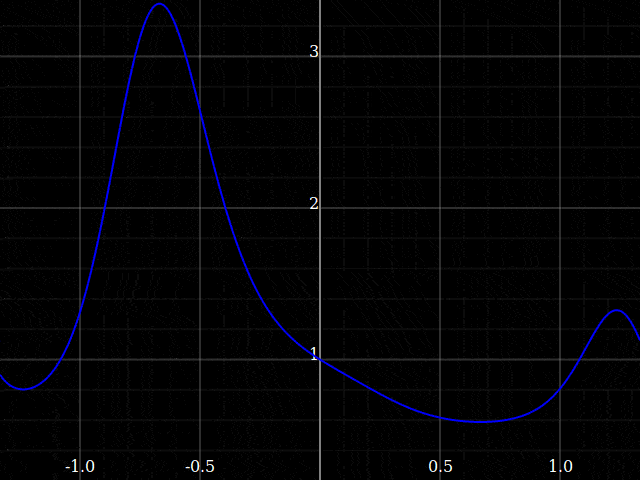What does the symbol nabla indicate?
We may think of $ \nabla $ as an operator ( del operator ) in the following sense.
It takes a function $f$ and turns it into a vector $\nabla f$ .
$\nabla f= \left\langle \frac {\partial f}{\partial x},\frac {\partial f}{\partial y}, \frac {\partial f}{\partial z} \right\rangle $ is called the gradient vector.
The gradient vector points to the direction at which your function increases most rapidly.
For example if $$ f(x,y,z)= x+3y^2 -10z$$ Then $$ \nabla f (x,y,z)= \langle 1,6y,-10\rangle $$
and if there is a point given, say $(1,3,5)$, we can evaluate $ \nabla f (1,3,5)= \langle 1,18,-10\rangle.$
This vector points at the direction of maximum increase of our function at $(1,3,5).$
Nabla is a vector whose components are operators. In the three-dimensional case you quote, $\nabla=(\partial_x,\partial_y,\partial_z)$. It is not a vector in the usual sense (of vectors in $\mathbb R^3$), but it is a very convenient abuse of notation.
The example given in the question gives a convenient way to write the gradient of a function $f:\mathbb R^3\to\mathbb R$ as $$ \nabla f(x,y,z) = (\partial_xf(x,y,z),\partial_yf(x,y,z),\partial_zf(x,y,z)). $$ As it turns out, this kind of a derivative is useful.
If you have a function $g:\mathbb R^3\to\mathbb R^3$, there are two typical derivatives you will need. One of them is the divergence, which is the scalar quantity $\partial_xg_x(x,y,z)+\partial_yg(x,y,z)+\partial_zg(x,y,z))$. It is convenient to write this as $$ \nabla\cdot g(x,y,z), $$ since the formula does indeed look like an inner product of the vector $g=(g_x,g_y,g_z)$ and our $\nabla$.
The other one is the curl, which is given in terms of components as $$ (\partial_yg_z-\partial_zg_y,\partial_zg_x-\partial_xg_z,\partial_xg_y-\partial_yg_x). $$ (I omit the arguments for brevity.) This one looks like a cross product, and it is indeed typical to write it as $\nabla\times g(x,y,z)$.
The point is that there are these three basic instances where it is convenient to think of $\nabla$ as a vector of operators, even if such objects aren't studied in general.
How you've described it, it's used as the gradient of a function in multivariable calculus.
By itself, the nabla can be thought of as a vector of partial derivative operators, and when applied to a multivariable function, it represents the vector of partial derivatives of each component (dot product) and the direction of steepest ascent for some input:
$$\nabla = \begin{bmatrix}\frac{\partial}{\partial x} \\ \frac{\partial}{\partial y} \\ \frac{\partial}{\partial z} \\ \vdots\end{bmatrix}$$
$$\nabla f(x, y, z,\dots) = \begin{bmatrix}\frac{\partial}{\partial x}\,f(x, y, z,\dots) \\ \frac{\partial}{\partial y}\,f(x, y, z,\dots) \\ \frac{\partial}{\partial z}\,f(x, y, z,\dots) \\ \vdots\end{bmatrix}$$
The nabla can be applied to a number of different areas in multivariable calculus, such as divergence or curl. In all these cases, the nabla can be treated like a vector which you can dot or cross with another vector, such as a multivariable function. That said, it is an operator.
Conceptually, $\nabla$ is an operator that takes a scalar field (i.e., a smooth, real-valued function defined on some real space – the space is usually $\mathbb{R}^2$ or $\mathbb{R}^3$, but it could also be a higher-dimensional space or a curved manifold $M$) and gives you back a cotangent-vector field. $$ \nabla : (M\to\mathbb{R}) \to (M\to T^\ast(M)) $$ What does that mean? Well, instead of defining these terms directly, let me give the motivation for how they relate to the nabla. The idea behind a gradient (or any derivative, really) is that you want to locally simplify – linearise – a function/field. Let's consider the 1D case first, i.e. $M=\mathbb{R}$. Your function itself may have some whacky wavy course that makes it hard to do much with it, but locally (i.e., when zooming in on any given spot), it will be approximated very well by a simple straight line.

This approximation is a truncated Taylor expansion. Its slope is the derivative of the function. So, we have the operator $$\begin{align} \operatorname{approx}_{x_0} &: (\mathbb{R}\to\mathbb{R}) \to (\mathbb{R}\to\mathbb{R}) \\ \operatorname{approx}_{x_0} & f\:(x) = f(x_0) + f'(x_0)\cdot (x-x_0) \end{align}$$
The idea of nabla is to generalise this to higher-dimensional domains.
$$\begin{align} \operatorname{approx}_{x_0} &: (M\to\mathbb{R}) \to (M\to\mathbb{R}) \\ \operatorname{approx}_{x_0} & f\:(x) = f(x_0) + \operatorname{N\!A\!B}(x-x_0) \end{align}$$ There, we need some quantity that can take a local difference vector (a tangent vector in the tangent space $T_{x_0}(M)$) and spit out something similar to... whatever it is that $f$ does when its argument is perturbed by that vector. That quantity is $\operatorname{N\!A\!B}=\nabla f|_{x_0}$.
Generally speaking, this would just again be a function $$ \operatorname{N\!A\!B} : T_{x_0}(M) \to \mathbb{R} $$ ...but because we want the approximation to linearise $f$, it should specifically be a linear functional, i.e. an element of the dual space $T_{x_0}^{\ast}(M)$ of cotangent vectors.
That may sound complicated, but actually it turns out that the dual space of any sensible vector space, certainly of $\mathbb{R}^n$, is basically just $\mathbb{R}^n$ again. Namely, the dual vector $\operatorname{NAB}$ can be equivalently replaced with a scalar product with a vector, and for nabla, that vector contains the directional derivatives as entries. And that's how we usually see the nabla operator: $$ \nabla : (\mathbb{R}^n\to\mathbb{R}) \to (\mathbb{R}^n\to \mathbb{R}^n) $$ which then allows us to write the Taylor expansion as $$\begin{align} \operatorname{approx}_{x_0} &: (\mathbb{R}^n\to\mathbb{R}) \to (\mathbb{R}^n\to\mathbb{R}) \\ \operatorname{approx}_{x_0} & f\:(x) = f(x_0) + \nabla f|_{x_0}\cdot (x-x_0) \end{align}$$